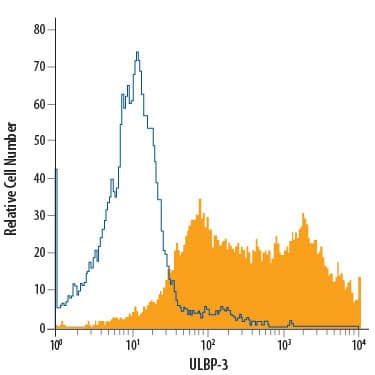Human ULBP-3 APC-conjugated Antibody
R&D Systems, part of Bio-Techne | Catalog # FAB1517A


Key Product Details
Species Reactivity
Validated:
Cited:
Applications
Validated:
Cited:
Label
Antibody Source
Product Specifications
Immunogen
Specificity
Clonality
Host
Isotype
Scientific Data Images for Human ULBP-3 APC-conjugated Antibody
Detection of ULBP‑3 in BaF3 Mouse Cell Line Transfected with Human ULBP-3 by Flow Cytometry.
BaF3 mouse pro-B cell line transfected with human ULBP-3 was stained with Mouse Anti-Human ULBP-3 APC-conjugated Monoclonal Antibody (Catalog # FAB1517A, filled histogram) or isotype control antibody (Catalog # IC003A, open histogram). View our protocol for Staining Membrane-associated Proteins.Applications for Human ULBP-3 APC-conjugated Antibody
Flow Cytometry
Sample: BaF3 mouse pro-B cell line transfected with human ULBP-3
Formulation, Preparation, and Storage
Purification
Formulation
Shipping
Stability & Storage
- 12 months from date of receipt, 2 to 8 °C as supplied.
Background: ULBP-3
ULBP-3 is a member of a family of cell-surface proteins that function as ligands for human NKG2D. ULBP-3 has also been described under the names RaeT1N (retinoic acid early transcript), NKG2DL3, and ALCAN-gamma. The name ULBP-3 derives from the original identification of three proteins, ULBP-1, -2, and -3, as ligands for the human cytomegalovirus glycoprotein UL16; they were designated UL16 binding proteins (ULBP). The gene for ULBP-3 resides in a cluster of ten related genes, six of which encode potentially functional glycoproteins. Amino acid sequence identity within this family ranges from 30‑60%. These proteins are distantly related to MHC class I proteins, but they possess only the alpha1 and alpha2 Ig-like domains, and they have no capacity to bind peptide or interact with beta2‑microglobulin. Some family members, including ULBP-3, are anchored to the membrane via a GPI-linkage, whereas others have transmembrane domains. ULBP-3 and several other family members are known to bind to human NKG2D, an activating receptor expressed on NK cells, NKT cells, gamma delta T cells, and CD8+ alpha beta T cells. Engagement of NKG2D results in the activation of cytolytic activity and/or cytokine production by these effector cells. The ULBPs are expressed on some tumor cells and have been implicated in tumor surveillance (1‑7).
References
- Cosman, D. et al. (2001) Immunity 14:123.
- Kubin, M. et al. (2001) Eur. J. Immunol. 31:1428.
- Sutherland, C. et al. (2002) J. Immunol. 168:671.
- Steinle, A. et al. (2001) Immunogenetics 53:279.
- Sutherland, C. et al. (2001) Immunol. Rev. 181:185.
- Pende, D. et al. (2002) Cancer Res. 62:6178.
- Radosavljevic, M. et al. (2002) Genomics 79:114.
- NKG2D and its Ligands (2002) http://www.RnDSystems.com/.
Long Name
Alternate Names
Entrez Gene IDs
Gene Symbol
Additional ULBP-3 Products
Product Documents for Human ULBP-3 APC-conjugated Antibody
Product Specific Notices for Human ULBP-3 APC-conjugated Antibody
For research use only